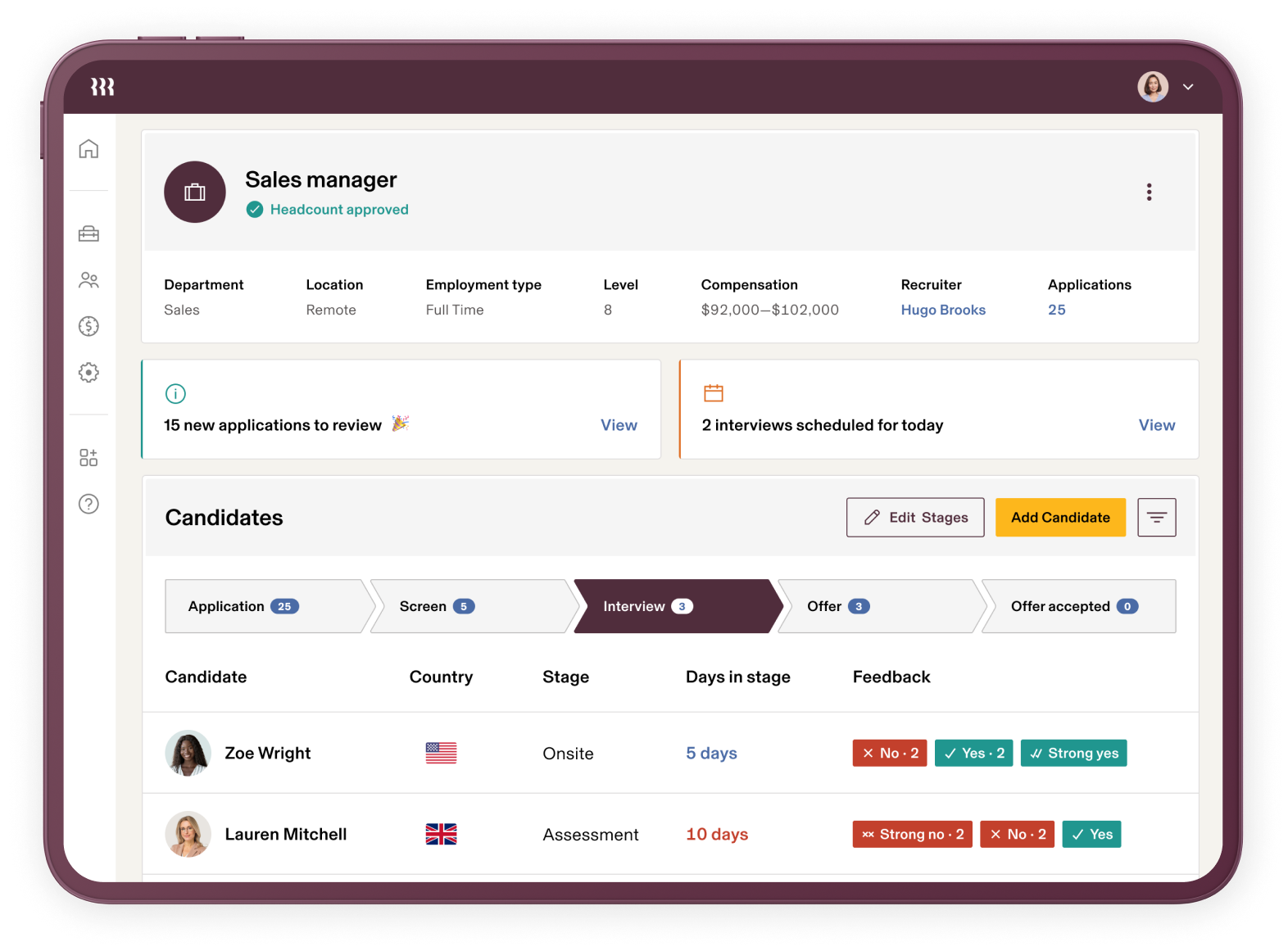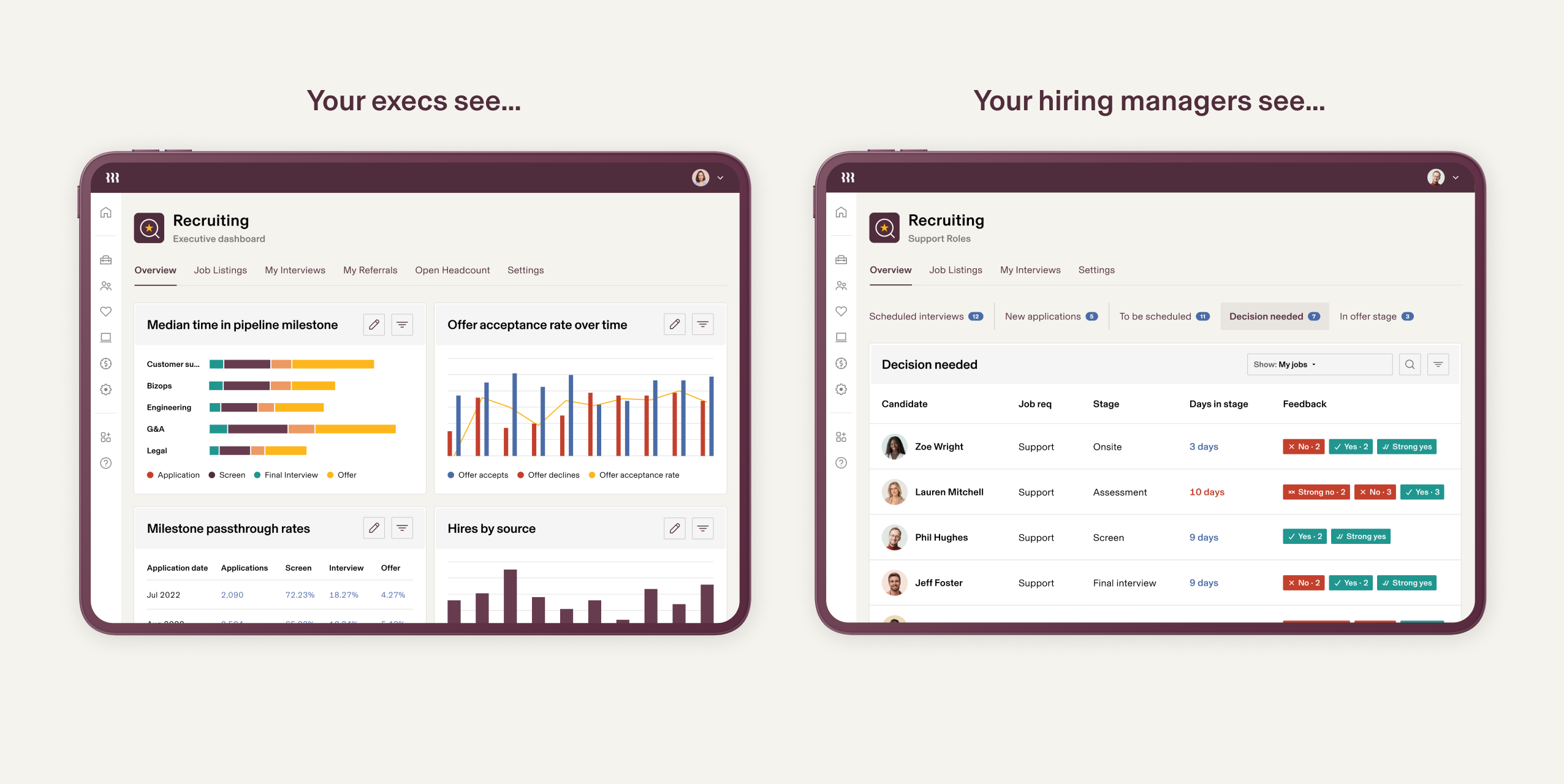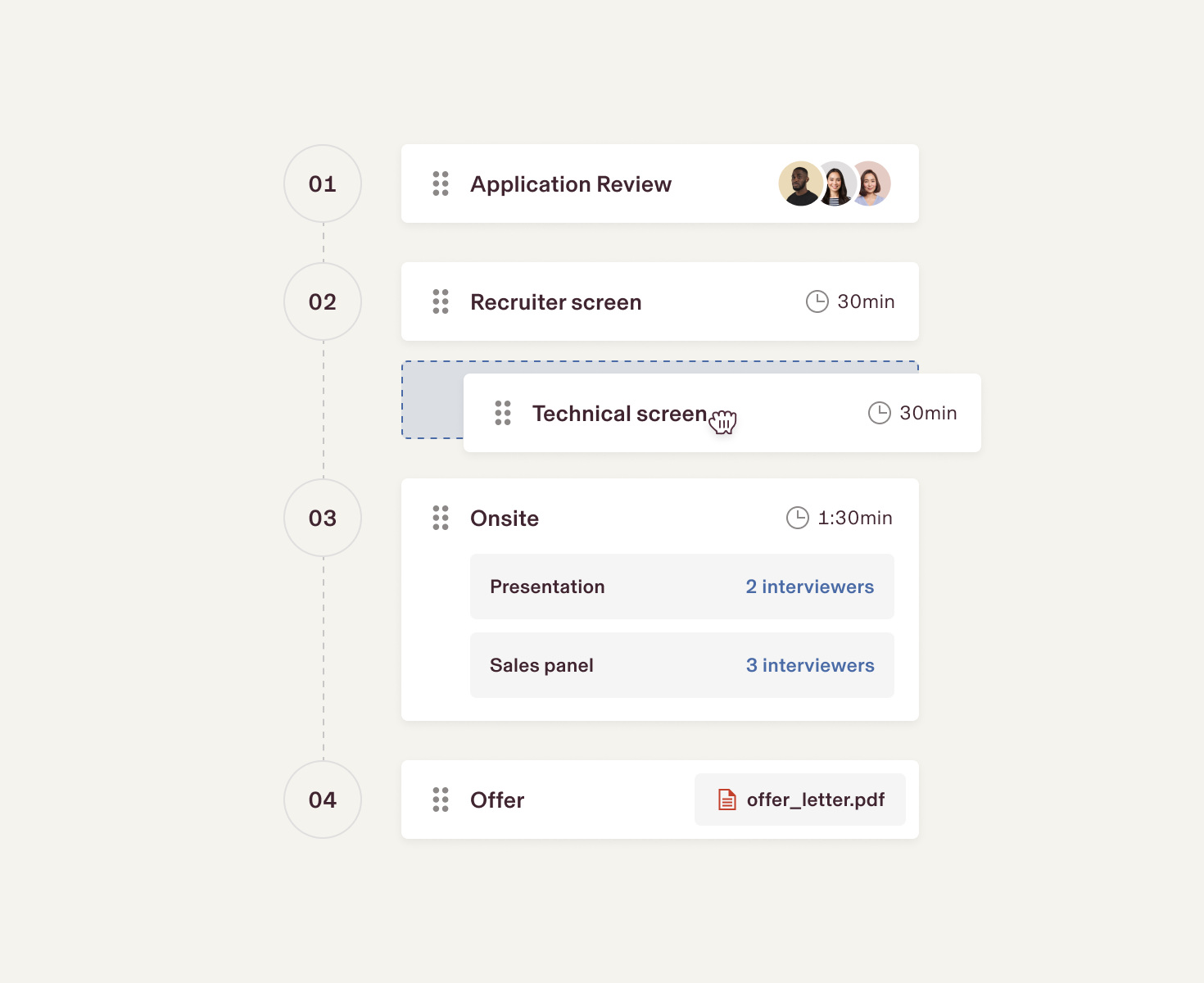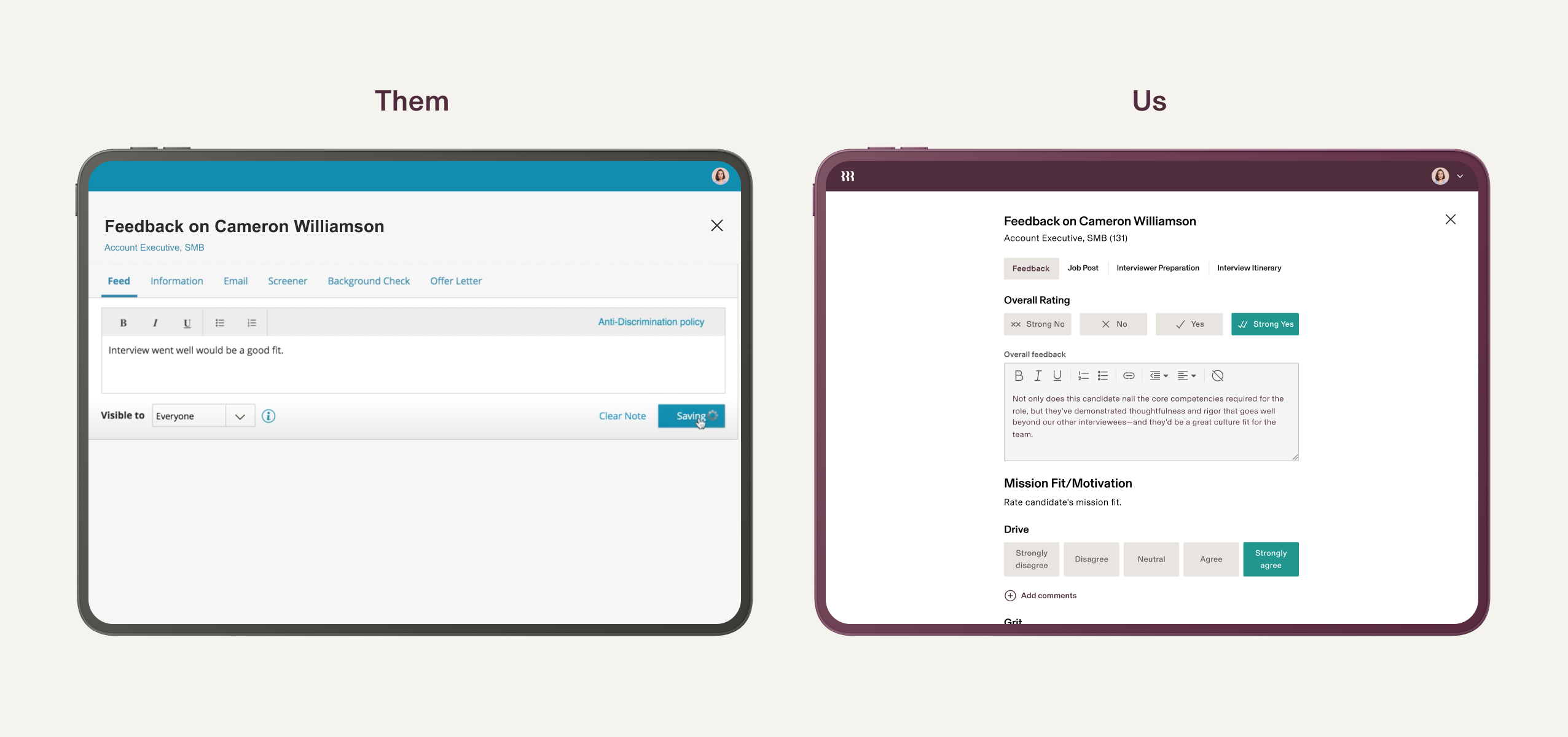Today, we’re launching Rippling Recruiting, our new applicant tracking system (ATS). It allows you to connect every step of your hiring process, automate all of the administrative work, and get your entire company hiring on all cylinders.

Why is recruiting so painful today?
Problem #1: Your recruiters and hiring managers can’t get the tools or data they need
Other applicant tracking systems can’t automatically give your hiring managers the ability to view and manage every aspect of their candidate pipelines right out of the box. They can’t implicitly see their approved headcount or comp bands, where candidates are in the funnel, or actually do things themselves like reject applications, without manual intervention from HR or Recruiting.
That’s because a standalone ATS isn’t connected to your HRIS, so it has no way of knowing who should have access to which pipelines, reports, or data. And an ATS that’s part of an all-in-one system other than Rippling works off of static permissions, which are always out of date and require constant manual upkeep. In practice, this means most of your hiring managers never get the access they need—it’s simply safer to limit access to a small set of people in HR and Recruiting.
As a result, countless administrative tasks get dumped onto your Recruiting team, who have to spend hours answering simple questions and pulling reports for hiring teams, instead of focusing on getting great talent in the door.
Problem #2: You can’t scale recruiting efforts due to lack of configurability
Other applicant tracking systems have limited configurability. Smaller companies tend to choose simplistic platforms that they quickly outgrow, while larger companies use systems that are not only clunky but lack the depth they need to build a custom, repeatable recruiting motion. As a result, they can’t configure every step of the process, like pipeline stages, feedback forms, and candidate email templates. Ultimately, these companies shoehorn every team and role into a one-size-fits-nobody recruiting process.
This leads to recruiters and hiring managers spending an inordinate amount of time doing manual work outside of the system to cobble together a process that works for their needs. Even worse, hiring managers in the same department adopt completely different processes, which not only creates a terrible candidate experience but makes it impossible to effectively measure and report on your recruiting effectiveness. And the more you hire, the more messy and pronounced these problems become.
Problem #3: Your recruiting data is constantly inaccurate and out-of-sync due to siloed systems
Ask any recruiter how they feel about the quality of their data and you’ll hear the same thing: “not good.”
With a standalone ATS, you can’t trust your recruiting data because it’s disconnected from your HRIS. That creates discrepancies. For example, your open and filled headcount will be out of sync because your HRIS and ATS don’t agree on which candidates have accepted offers, and who’s actually in-seat.
Without a single source of truth that stretches from applicant to fully onboarded employee, teams spend hours downloading, filtering, and verifying recruiting metrics—even before trying to tie those metrics back to HR and Finance data. As a result, you need a data science team just to answer questions like, “What are our best sourcing channels?” and “Which recruiters are best at finding and hiring candidates?” Producing custom reports is even more difficult.
Problem #4: There are constant alignment issues because your headcount plan, recruiting system, and HRIS aren’t in sync
Today’s applicant tracking systems are narrowly focused on sourcing and recruiting. They don’t consider the entire hiring lifecycle and deeply integrate with your headcount plan, onboarding systems, and HRIS.
This approach isn’t scalable. Hiring is one of the most cross-functional processes in a company. It starts with headcount planning in the Finance department—well before recruiting creates requisitions and sources candidates—and extends into the HR department, which handles getting the new employee onboarded. On top of that, managers are constantly requesting headcount for new roles and backfills for employees who depart or transfer.
When every stage of hiring happens across different systems, you can’t align everyone on cross-functional objectives like, “Which roles has Finance actually approved and when can they be hired?” or “How many candidates haven’t just signed their offer, but are onboarded and in-seat?” Since you can’t align around a single source of truth for all your data, you run into significant problems: You can’t establish accountability over the hiring process, your hiring goals are at risk, and you have to constantly build or manage integrations just to keep up.
How Rippling Recruiting helps your company hire on all cylinders
Give every hiring manager their own recruiting command center
Rippling automatically gives everyone—your sourcers, recruiters, hiring managers, and executives—their own recruiting command center, tailored to their scope. And when recruiters or managers transition or leave, Rippling automatically transfers requisitions and access to the right person, so nothing falls through the cracks, and no one has access to data they shouldn’t see.
Rippling makes it possible for hiring managers to truly own their hiring goals, without any need to manually manage access or permissions. Everyone can clearly see their most pressing tasks, track their pipelines and important metrics, and manage their reqs, so your recruiters can focus on recruiting instead of data requests and admin work.

Build an efficient and repeatable hiring process for every team
With Rippling, every team can tailor every aspect of their hiring process, including pipeline stages and methods of candidate assessment. You can build the exact experience you want, no matter what your company looks like. For example, if you don’t want to start out with custom pipelines, you can use our default templates. At any point, you can add or rearrange stages, incorporate candidate assessments, and iterate on every detail.

One critical component of any hiring process is interviewer feedback. In other systems, you can’t get meaningful interview feedback because you can only collect it through a plain text box. As a result, you can’t specify areas of focus for interviewers or provide ratings for specific topics. Our customizable feedback forms allow you to collect structured and measurable feedback via custom scorecards, rating scales, and questionnaires for each interviewer in your process. You can capture reportable, actionable feedback and consistently deliver a great candidate experience.

In Rippling Recruiting, every single feature you expect from a best-in-class ATS—from built-in scheduling to customizable email templates—is available at your fingertips, so you can customize and scale your process with the click of a button.
Supercharge recruiting with better data and deeper insights
With Rippling, all of your data lives in one unified system, meaning it’s always accurate and up-to-date. You’ll never have to worry about outdated spreadsheet exports, manual data reconciliation, or cross-department finger-pointing ever again. Here’s how:
- Your Recruiting data (i.e. your candidate pipeline) is always accurate because Rippling knows exactly where every candidate is, across every stage of every team’s interview process, and who has new and stale offers out.
- Your HR data (i.e. your in-seat employees) is always accurate because Rippling knows exactly who accepted their offer, where they are in the onboarding process, and whether they actually showed up on their first day.
- Your Finance data (i.e. your headcount plan and costs) is always accurate because Rippling knows exactly how many people have been approved and which roles have been filled (or haven’t, in cases where a candidate has reneged on their offer after the fact).
This means you can instantly see key metrics—like top sources, pipeline rollups, time-to-fill reports, and offer acceptance rates—with off-the-shelf reports. And at any point, you can filter, pivot, and customize your reports to get total control of your recruiting data, with just a few clicks.

Rippling also allows you to combine the data in your ATS with every piece of employee data in your HRIS, so you can get completely new—and much more valuable—insights into your recruiting motion.
For example, you can compare employee performance data with the scores they received on their interviewer feedback forms. That lets you answer strategic questions like “Which interviewers are the best at identifying top talent?”

Rippling Recruiting makes it simple to get the metrics you want and easy to go deeper with unparalleled insights. And because it gives you instant visibility into the entire employee lifecycle, you can spend less time pulling data and more time acting on it.
Connect and automate every step of your hiring process
Whereas other systems start at sourcing and end at recruiting, Rippling Recruiting connects every step of the hiring lifecycle and automates all of the administrative work along the way, no matter your company size.

You can easily approve new headcount for every team through Rippling Headcount Planning & Compensation Bands, both of which are deeply integrated with Rippling Recruiting. This ensures that everyone can see exactly how many people they’re allowed to hire—and how much they can pay them—based on the role, level, location, and more.

From there, every team can easily open reqs, post them to over 25,000 job boards, assign an interview panel, and schedule meetings—without ever leaving Rippling.
And when you eventually find the right candidate, you can simply click “Hire” and go from final interview to offer to onboarding in 90 seconds. Rippling even updates your headcount plan, so everything stays in sync. Backfills are just as easy: When employees transition or leave, you can instantly create and approve requisitions without painful emails, forms, or last-second meetings.

Every single step is connected right out of the box, which means Rippling Recruiting can scale with your company like no other ATS. Even if you don’t have formal headcount planning today, when the time comes, you can seamlessly slot in a new process without the need for any additional administrative work.
Ready to start hiring on all cylinders?
We know that recruiting is a team sport. That’s why Rippling Recruiting helps everyone involved in the hiring lifecycle do it better. Right out of the box, Rippling automatically provides every team with the real-time, accurate data they need to do their job, and gives you the tools to build a recruiting engine that not only improves the effectiveness of your recruiting team but has your entire company hiring on all cylinders.
If you’re a customer, you can get started here.
If you’re not a Rippling customer yet, you can request a demo here.





